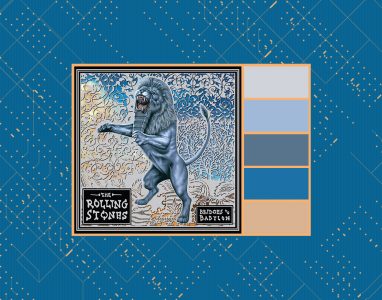Thursday Throwback is a weekly colour scheme inspired by an iconic album cover of yesteryear. This week’s throwback is the 1997 album “Bridges to Babylon” by The Rolling Stones. The colours are as follows:
| Colours | HEX | RGB | HSB | CMYK | LAB |
|---|---|---|---|---|---|
| Colour 1 | #D0D3D9 | 208, 211, 217 | 220, 4, 85 | 4, 2, 0, 14 | 84, 0, -3 |
| Colour 2 | #A0B9D9 | 160, 185, 217 | 214, 26, 85 | 26, 14, 0, 14 | 74, -1, -18 |
| Colour 3 | #58748C | 88, 116, 140 | 208, 37, 55 | 37, 17, 0, 45 | 47, -3, -16 |
| Colour 4 | #1C71A6 | 28, 113, 166 | 203, 83, 65 | 83, 31, 0, 34 | 45, -5, -35 |
| Colour 5 | #D9B391 | 217, 179, 145 | 28, 33, 85 | 0, 17, 33, 14 | 75, 8, 22 |
“Bridges to Babylon” is the 21st studio album by the English rock band The Rolling Stones. The album was released on the 29th September 1997 through Virgin Records.
The album “Bridges to Babylon” was recorded in Los Angeles between March and September 1997. During this time, The Rolling Stones collaborated with several producers, including the Dust Brothers, Don Was—who had previously worked on their album “The Voodoo Lounge”—and Rob Fraboni. This collaboration resulted in a diverse array of styles throughout the album. Notably, Mick Jagger and Keith Richards experienced some creative tension due to differing musical visions; Jagger favoured a more modern sound while Richards leaned towards traditional elements. This dynamic ultimately contributed to the eclectic nature of the album.
The cover art was crafted by Stefan Sagmeister, a distinguished graphic designer celebrated for his innovative and often provocative work. It features a striking image of a blue lion with a beard reminiscent of those seen on Mesopotamian deity statues. Set against an intricately decorated background, the lion is depicted rearing up on its hind legs as it roars—a design achieved through photography combined with digital manipulation techniques. This imagery became iconic during the band’s subsequent tour and remains associated with this era of The Rolling Stones.
Upon release, “Bridges to Babylon” debuted at No. 3 on both the UK Albums Chart and the US Billboard 200 and achieved Platinum certification in several countries including the United States, United Kingdom, and Canada. The lead single “Anybody Seen My Baby?” reached top 20 positions across various countries and became one of its most recognisable tracks.
Although critical reception was mixed—with some praising their experimental approach and others noting a lack of cohesion—the album has been acknowledged over time for its ambitious attempt to blend classic rock with contemporary trends from the late 1990s. While not as universally acclaimed as earlier works by The Stones, it has gained appreciation for its experimental nature and willingness to evolve their sound.
The influence of “Bridges to Babylon” can be seen in subsequent rock bands that have sought to integrate electronic elements into traditional rock frameworks. Additionally, The Stones’ collaboration with Dust Brothers paved the way for similar cross-genre partnerships within rock music.
Overall, “Bridges to Babylon” is regarded as an important entry within The Rolling Stones’ later catalogue—demonstrating their continued relevance amidst changing musical landscapes at century’s end—and stands out as an intriguing chapter showcasing enduring creativity despite decades-long careers marked by risk-taking endeavours even if it does not frequently appear among “best-of” lists.
Did you like this week’s colour scheme? Do you fancy using it for your next release cover? Then visit the shop or contact the founder!

